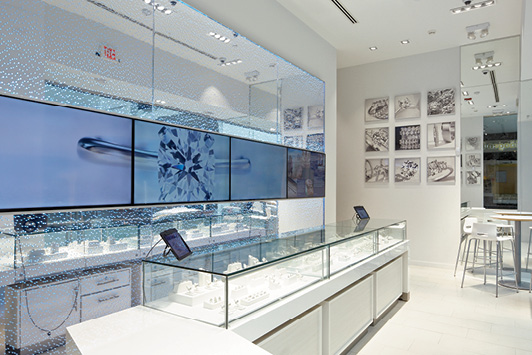
Not all that long ago, jewelry retailers believed that the internet — and its related technologies, such as mobile — would be the end of traditional stores. In fact, the term “showrooming” was once seen as negative, and referred to the practice of customers browsing in person and then finding the best price online. But times have changed, and savvy retailers have turned the tables on old-fashioned ideas about the separation of brick-and-mortar and digital shopping. That’s where the new definition of showrooming comes in.
Today’s model
Modern showrooming is a space for consumers to get hands-on experience with a product they will purchase at a later time — not unlike traditional automobile dealerships.
“A showroom is a store space for showcasing products and options, and creating an experience where [customers] can purchase a product which is then shipped to them,” explains Ben Smithee, CEO of The Smithee Group, a consumer consultancy specializing in millennial marketing. “[It’s designed] to sell product, but not carry inventory.”
One example is Blue Nile’s webrooms, which allow customers to look at engagement rings and fine jewelry before buying them online. The physical locations offer access to Blue Nile’s in-store selection, plus online access to the full catalog via tablet.
“[Webrooms are] staffed by our non-commissioned [salaried] diamond and jewelry consultants, [who] answer questions and help with purchases,” says Amanda Winters, public-relations manager for the digitally native jewelry retailer, which has opened six US showroom locations. “Shoppers can decide if they want to order on tablets in the webroom, or go home and order at their convenience from a PC, tablet or smartphone.”
A good fit
For diamond-jewelry retailers, the concept is appealing. “We’re starting to see examples of showrooming,” says Michael Brown, a partner in A.T. Kearney’s Consumer Products and Retail Practice, where he heads both the omni-channel team and the mass, discount and big-box sector team. “For example, Tiffany is able to get a piece from any store in its network. If a piece isn’t in one store, they can get it to another.”
But the concept isn’t perfect for every retailer, he concedes. “Your moderately priced rings will need immediate fulfillment [since they’re available as-is]. But not higher-end stores that lean more toward custom [pieces, which take longer to finish anyway].”
Custom and engagement pieces, Smithee believes, are particularly well suited for a showroom-style store.
“If I were a custom jeweler, I would create a showroom focused on taking product from mind to market,” he says. “Showing customers how we choose stones, and the CAD [computer-aided design] process, like what [jewelry supplier] Stuller is doing. And then customers have their finished product delivered, or they can come into the store and get it. This will also work for independent designers, because instead of having a 1,000-square-foot space, they can have three separate 200-square-foot showroom locations.”
There are also other advantages, especially when it comes to inventory. In addition to eliminating the need for large retail locations to carry stock, says Brown, showrooming’s small footprint requires retailers to be more selective in what they carry, which can keep them from hanging on to outdated pieces. “There’s a reason not to be overburdened with inventory that doesn’t sell,” he adds.
Taking the pressure off
The gap between conventional retail and showrooming in the jewelry industry isn’t that wide, according to Smithee.
“The current sales floor is already set up like a showroom, so it’s more of a mentality shift,” he says. “The front end of the business will look the same, but the back end will change. For retailers, they could even rely on manufacturers and brands to drop-ship [ship directly to the consumer or store, rather than via the usual distribution channels].”
Still, traditional retailers may not see the benefit of showrooming, which Winters believes is a mistake. “It’s really about putting the customer first,” she says. “Whether they choose to shop on their computer, mobile device or in one of our webrooms, we want to make sure they get an easy, pressure-free experience.”
In other words, it’s about meeting shoppers on their terms, “without high-pressure sales tactics and needlessly inflated prices, whether they are on a device or in a mall,” Winters notes.
Smithee sees the shift to showrooming as a natural progression for the jewelry industry, rather than a sea change.
“Jewelry stores are already not showing every single size and every single sample,” he says. “You’re already talking about [an] experience, and not ‘How quickly can I box this up for you?’ And a true showroom is an experiential place.... It’s not about the room. It’s about the show.”
Image: Blue NileArticle from the Rapaport Magazine - April 2018. To subscribe click here.